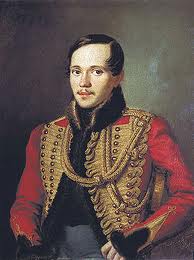Death of a Poet: Difference between revisions
m (moved Mikhail Lermontov's "Death of a Poet" to Death of a Poet) |
No edit summary |
||
| (One intermediate revision by the same user not shown) | |||
| Line 1: | Line 1: | ||
====Date: [[:Category: | ====Date: [[:Category:1837|1837]]==== | ||
====Region: [[:Category:Russia and Central Asia|Russia and Central Asia]]==== | |||
====Subject: [[:Category:Political/Economic/Social Opinion|Political/Economic/Social Opinion]]==== | |||
====Medium: [[:Category:Literature|Literature]]==== | |||
====Medium: [[:Category:Literature|Literature | |||
---- | ---- | ||
[[File:Lermontov.jpg|right]] | |||
'''Artist:''' Mikhail Lermontov (1814 - 1841) | |||
'''Confronting Bodies:''' Tsar Nicholas I and Russian bureaucrats. | |||
'''Confronting Bodies:''' Tsar Nicholas I and Russian | |||
'''Date of Action:''' 1837 | |||
'''Location:''' Russia | '''Location:''' Russia | ||
'''Description of Artwork:''' ''Death of a Poet'' was written in response to the death of Aleksandr Pushkin in a duel. Most of it was developed while Pushkin was merely wounded and this portion praises him and insults his opponent. However when Pushkin died three days after the duel from wounds he sustained, Lermontov added a new section in a fit of rage. This passage denounces the aristocrats around the throne (who apparently supported Pushkin's opponent) as the executioners of freedom and genius. <P> | |||
'''Description of Artwork:''' | |||
'''The Incident:''' An aristocrat who saw the poem as an attack on the best families in Russia showed it to the head of the secret police and emperor Nicholas I. The copy sent to the emperor was labeled "A Call to Revolution." He immediately considered it political subversion and that it implied his own connection to the death of Pushkin. <P> | '''The Incident:''' An aristocrat who saw the poem as an attack on the best families in Russia showed it to the head of the secret police and emperor Nicholas I. The copy sent to the emperor was labeled "A Call to Revolution." He immediately considered it political subversion and that it implied his own connection to the death of Pushkin. <P> | ||
'''Results of Incident:''' Although the head of the secret police found nothing objectionable in the piece, circumstances forced him to denounce it as seditious. Nicholas had Lermontov examined for insanity and then exiled him to the Caucasus as an officer with the Dragoons, where he died, ironically, in a duel. <P> | |||
'''Results of Incident:''' Although the head of the secret police found nothing objectionable in the piece, circumstances forced him to denounce it as seditious. Nicholas had Lermontov examined for insanity and then exiled him to the Caucasus. <P> | |||
'''Source:''' Censorship: A World Encyclopedia. Ed. Derek Jones. Chicago; London: Fitzroy Dearborn, 2001. | '''Source:''' Censorship: A World Encyclopedia. Ed. Derek Jones. Chicago; London: Fitzroy Dearborn, 2001. | ||
[[Category:1837]] | |||
[[Category:1830s]] | |||
[[Category: | [[Category:19th century]] | ||
[[Category:Russia and Central Asia]] | [[Category:Russia and Central Asia]] | ||
[[Category:Political/Economic/Social Opinion]] | [[Category:Political/Economic/Social Opinion]] | ||
[[Category:Literature]] | [[Category:Literature]] | ||
[[Category:Mikhail Lermontov]] | [[Category:Mikhail Lermontov]] | ||
{{DISPLAYTITLE:<span style="font-style: italic;">Death of a Poet</span>}} | |||
__NOTOC__ | __NOTOC__ | ||
Latest revision as of 18:14, 29 December 2011
Date: 1837
Region: Russia and Central Asia
Subject: Political/Economic/Social Opinion
Medium: Literature
Artist: Mikhail Lermontov (1814 - 1841)
Confronting Bodies: Tsar Nicholas I and Russian bureaucrats.
Date of Action: 1837
Location: Russia
Description of Artwork: Death of a Poet was written in response to the death of Aleksandr Pushkin in a duel. Most of it was developed while Pushkin was merely wounded and this portion praises him and insults his opponent. However when Pushkin died three days after the duel from wounds he sustained, Lermontov added a new section in a fit of rage. This passage denounces the aristocrats around the throne (who apparently supported Pushkin's opponent) as the executioners of freedom and genius.
The Incident: An aristocrat who saw the poem as an attack on the best families in Russia showed it to the head of the secret police and emperor Nicholas I. The copy sent to the emperor was labeled "A Call to Revolution." He immediately considered it political subversion and that it implied his own connection to the death of Pushkin.
Results of Incident: Although the head of the secret police found nothing objectionable in the piece, circumstances forced him to denounce it as seditious. Nicholas had Lermontov examined for insanity and then exiled him to the Caucasus as an officer with the Dragoons, where he died, ironically, in a duel.
Source: Censorship: A World Encyclopedia. Ed. Derek Jones. Chicago; London: Fitzroy Dearborn, 2001.
